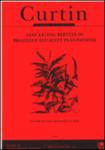Leaf-eating beetles in Brazilian eucalypt plantations
| dc.contributor.author | Dos Anjos, N. | |
| dc.contributor.author | Majer, Jonathan | |
| dc.date.accessioned | 2017-01-30T10:41:05Z | |
| dc.date.available | 2017-01-30T10:41:05Z | |
| dc.date.created | 2008-11-12T23:21:17Z | |
| dc.date.issued | 2003 | |
| dc.identifier.citation | Dos Anjos, Norivaldo and Majer, Jonathan D.. 2003. Leaf-eating beetles in Brazilian eucalypt plantations: Curtin University of Technology. | |
| dc.identifier.uri | http://hdl.handle.net/20.500.11937/4710 | |
| dc.description.abstract |
Tree plantations in Brazil are grown for pulp,paper,charcoal, ubber,vegetable oil, resin,tannin,fuel,shade for livestock and for the furniture industry. Although tree plantations must be established in an ecologically sustainable manner, as with all crops a forest plantation needs to be profitable in order to maintain itself as an agribusiness activity. An exception is when they are used for land revegetation or soil rehabilitation. Many different species have been used in tree plantations in Brazil, but eucalypts are the most predominant cultivated trees. However, many problems have risen with eucalypt plantations, as has happened with other types of monocultures.Pest outbreaks are among these problems, as numerous native insects have become serious pests in these plantations. Brazilian involvement with eucalypts began in 1904 and, to date, more than 200 invertebrate species are known to be harmful to the plantations. Defoliators, such as leafcutting ants, caterpillars, and leaf-eating beetles are the most important groups of pests. Problems with leaf-eating beetles began in 1925, when the Australian weevil Gonipterus scufellatus was introduced in the Argentine, and then into the Brazilian eucalypt plantations. The first major problem associated with a native leaf beetle arose in 1953, when the chrysomelid Sternocolaspis quatuordecimcostata was reported as a serious pest of eucalypts plantations. Currently, more than 40 leaf-eating beetles species have been reported as eucalypt pests; the most important species being Cosfalirnaifa ferruginea (Chrysomelidae), Gonipterus scufellatus (Curculionidae), Bola flavolineata (Scarabaeidae) and Lampefis nigerrima (Buprestidae). The life histories of these insects have not been substantially studied and their economic importance has only been delimited for a few species. Chemical sprayings have been the main control technique to relieve pest outbreaks. However, appropriate technology for preventing outbreaks and making control decisions are in progress to avoid chemical interventions in the Brazilian forestry operations. | |
| dc.title | Leaf-eating beetles in Brazilian eucalypt plantations | |
| dc.type | Report | |
| curtin.note |
Originally published as: | |
| curtin.note |
Curtin University of Technology | |
| curtin.note |
Bulletin Number 23 | |
| curtin.note |
ISSN 0158 3301 | |
| curtin.department | Department of Environmental Biology (Curtin University of Technology) | |
| curtin.identifier | EPR-327 | |
| curtin.accessStatus | Open access | |
| curtin.faculty | Division of Resources and Environment | |
| curtin.faculty | Muresk Institute | |
| curtin.faculty | Department of Environmental Biology |

